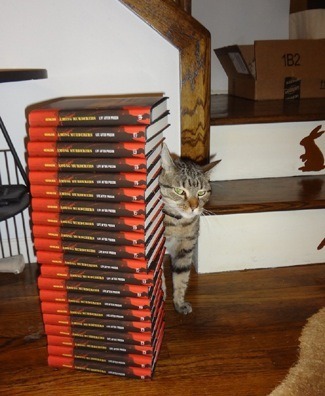Meet a NYA Artist: Sabine Heinlein
Sabine Heinlein
NYFA talks to Sabine Heinlein (2009 Nonfiction Fellow) about her new book Among Murderers: Life After Prison, published by University of California Press in March 2013.
NYFA: First of all, congratulations on your forthcoming book Among Murderers: Life After Prison. Will you introduce the book and explain what inspired it?
SH: Thank you! I think at the heart of this book is my interest in the human struggle. Questions like, ‘How do people overcome obstacles?’ and ‘How do you start over from nothing?’ have always been tremendously important to me. When I moved to New York I had no friends and no job. New York is a very competitive city where you are defined by what you do for work, so I became interested in New Yorkers who didn’t work. I talked to trophy wives, retirees, mentally ill people and people who had lost their jobs. I started visiting so-called “job readiness classes” run by reentry organizations and talked to the student ex-cons and to the teachers (often ex-cons themselves). Through these classes and the organizations that offered them I saw that there was so much missing from people’s lives, so much at stake and so many obstacles that needed to be addressed. I felt like someone had to talk to these people and tell their stories. I wanted to show how people got to this point in their lives.

Among Murderers: Life After Prison book cover,
University of California Press, March 2013
Photo courtesy Sabine Heinlein
NYFA: How did you choose the book’s three protagonists?
SH: I interviewed a lot of ex-cons at various organizations until I found my book’s main characters. While reporting on a reentry event in Albany I met Angel. I sat next to him on the bus back to New York City. Angel had spent almost 30 years in prison for a horrible crime he committed as an 18-year-old. He was funny and charming, but I also noticed that he had an edge, a tension in him. He seemed like the perfect subject.
At the halfway house Angel became friends with Bruce and Adam. There was this sense that they could relate to each other not only because all three of them were men of color, had grown up in New York and had spent several decades locked up. They also related to each other because they had taken another human being’s life.
I noticed that the men dealt with their experiences in entirely different ways. They each had their own idiosyncratic approaches to life. I hope that the readers of my book will really “get to know” Bruce, Adam and Angel. Only if we understand that we are dealing with real people—not statistics, “clients” or “survey participants”—will we be able to address America’s reentry crisis.
NYFA: Will you share with us an especially memorable experience you had with Angel, Bruce or Adam in the course of working on this book?
SH: There are many, but I often think of our trip to Williamsburg, Brooklyn. One of the many parole stipulations forbade the men to leave the five boroughs, so we were coming up with stuff we could do in New York. Adam said that he had read about Williamsburg while incarcerated, something about how Williamsburg is the new East Village. In prison he had this scrapbook into which he would paste articles about places he wanted to visit. I lived in Williamsburg when I first moved to New York, so one weekend afternoon I met with the three men at the subway to give them a little tour. We went to a bagel café and to the waterfront, looked at graffiti and walked south to Williamsburg’s Hasidic neighborhood. The trip helped me understand how hard it is to relate to the outside—“to master your freedom”—after 20 or 30 years behind bars, and how difficult it is for former prisoners to make independent decisions. I also felt how difficult it is for us and for them to accept people who are different. Adam always talked about his “prison armor” and how he couldn’t find the zipper to remove it. I felt that society had its very own “armor,” which it is incapable of taking off..
NYFA: What unforeseen challenges, if any, occurred in writing this book, and how did you deal with them?
SH: Narrative nonfiction books have very specific challenges. You have to adapt to people’s ways, and your subjects have to adapt to you. The goal is always to make a meaningful connection with the other person. But each situation is different, so flexibility is very important, and so is a certain “social fearlessness.”
I always felt that—despite the difficulties of being a female writer doing narrative nonfiction about the downtrodden at a time where publishing houses are struggling for their existence—there are plenty of rewards. You are getting into another person’s mind and into his life! That’s a huge privilege. And it’s a learning experience, an adventure. Sitting in front of the computer or on the couch, writing, thinking, reading, and wearing your old gym pants is a tremendous privilege. If you have a cat and a rabbit next to you, as I do, it’s an even bigger privilege. Of course, eventually you have to get up and make some money because the animals are not pulling their weight.

Author’s cat Gilbert acclaims Among Murderers: Life After Prison
Photo courtesy Sabine Heinlein
NYFA: You hold a master’s degree in journalism from NYU. What are your thoughts on maintaining journalistic integrity in narrative nonfiction? Have your beliefs evolved during the course of writing this book?
SH: I think truth is indispensable. It’s a responsibility, a duty. You owe it to yourself, your subjects and your readers. Truth is also fun. Reality provides all these amazing dialogues and scenes!
Of course, a narrative nonfiction author has a certain literary freedom (and responsibility). You cut, assemble and arrange. You decide what to highlight and how to shape the narrative. So it is not only your subject’s narrative anymore, it becomes your own. With your composition you create a self-encompassing reality. The way you see things always differs from the way someone else sees them.
NYFA: You seem especially concerned with issues of racial oppression and inequality. How has your background, and experience transitioning to the United States from Germany, informed your perspective on these issues?
SH: Racial oppression and inequality have always seemed blatant to me in the U.S. Growing up in a small Bavarian village—not quite as romantic as it might sound—I very rarely saw people of color. I hadn’t been exposed much to “the problem.” So when I came here I was shocked. This is not to say that there is no social injustice in Germany. Germany has a screwed up relationship with its Turkish and Greek guest workers, for example. There are huge inequalities. But the gap between rich and poor isn’t as large as it is in America. There are certain givens in Germany, like health insurance and maternity leave. And, of course, far fewer people are in prison and on parole. In general, when you move to a foreign country certain things will appear to you more intensely. For me, social injustice was one of these things.
NYFA: What are you currently working on?
SH: Shhhhh….
NYFA: You received a NYFA Fellowship in Nonfiction in 2009. Can you talk about the impact the fellowship had on your work?
SH: The NYFA Fellowship had a huge impact on my work. It was the first major recognition paid to my work—and to my book in particular. I had just finished writing the first 30 pages and I didn’t have much to hold on to. I wasn’t sure how the story would develop and whether I could find a publisher. NYFA gave me hope. I joined a community of people who are dedicated, open-minded, eager and fun to hang out with. (I ended up meeting several other NYFA fellows on residencies.) I also really enjoyed the NYFA-sponsored community workshop I organized at my local Queens Library, where I got to meet some of my neighbors.
NYFA: Do you have advice for emerging writers?
Do you want to do this? Really want to do it? Then go ahead. Be genuine and empathetic. If there are doubts or incongruities, address them. And if you’re a woman, don’t buy make-up; it’s a waste of your money and it was possibly tested on animals. Besides, make-up very rarely makes a person look better.
—Interview by Lara Hidalgo
For more information on Sabine and her upcoming appearances, please visit her website.




